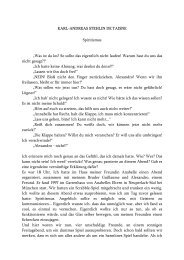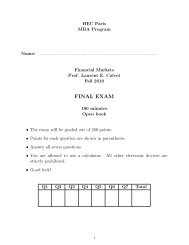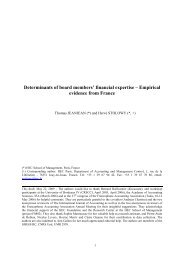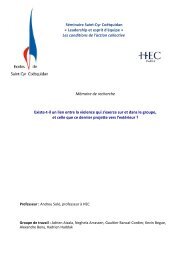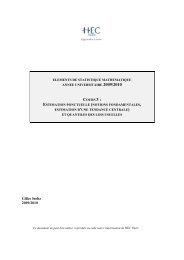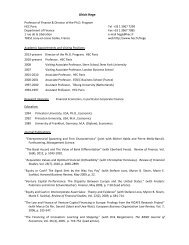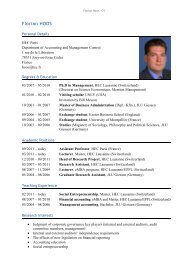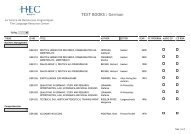Multifractality of US Dollar/Deutsche Mark Exchange Rates - Studies2
Multifractality of US Dollar/Deutsche Mark Exchange Rates - Studies2
Multifractality of US Dollar/Deutsche Mark Exchange Rates - Studies2
You also want an ePaper? Increase the reach of your titles
YUMPU automatically turns print PDFs into web optimized ePapers that Google loves.
to encourage further research by demonstrating the empirical content <strong>of</strong> the model, and to lay<br />
groundwork that suggests which approaches will be most fruitful.<br />
The structure <strong>of</strong> the paper is as follows: Section 2 presents the primary estimation methodology.<br />
Multifractal processes are reviewed and their scaling properties are related to restrictions upon<br />
moments <strong>of</strong> the data. This leads to an informal test <strong>of</strong> multifractality, and an estimation method<br />
for the scaling function, which describes growth rates <strong>of</strong> moments as the time scale increases.<br />
Section 3 applies these methods to <strong>Deutsche</strong>mark / <strong>US</strong> <strong>Dollar</strong> exchange rate data. We find strong<br />
evidence <strong>of</strong> scaling, consistent with the predictions <strong>of</strong> the MMAR.<br />
Section 4 reviews the multifractal spectrum, which is a renormalized density <strong>of</strong> points in time<br />
with different degrees <strong>of</strong> local regularity. We show that the multifractal spectrum can be estimated<br />
by Legendre transform <strong>of</strong> the scaling function. Section 5 carries out the Legendre transform on the<br />
estimated scaling function and discusses these results. The MMAR components are recovered from<br />
the estimated multifractal spectrum. Finally, Monte Carlo simulations show a striking resemblance<br />
to the DM/<strong>US</strong>D data, although consistent replication <strong>of</strong> scaling requires large simulated sample<br />
sizes. This result is discussed in Section 5.<br />
Section 6 simulates GARCH and FIGARCH processes, using parameters obtained from pre-<br />
viously published research on exchange rates. Lack <strong>of</strong> long memory is made intuitively clear by<br />
graphical representations <strong>of</strong> GARCH over long time intervals. Similar FIGARCH simulations show<br />
long memory, but lack variability at high frequencies when compared to the data (or the MMAR).<br />
Neither GARCH nor FIGARCH captures the scaling properties <strong>of</strong> the data with consistency, even<br />
at large sample sizes. We discuss how to interpret these results.<br />
Section 7 conducts a variety <strong>of</strong> robustness tests. We apply several seasonal adjustment filters to<br />
the high frequency data, split the data to test for model stationarity, and perform similar tests with<br />
the Japanese Yen/ <strong>US</strong> <strong>Dollar</strong> series. Scaling properties are robust to reasonable transformations <strong>of</strong><br />
the DM/<strong>US</strong>D data. Scaling behavior in the Yen/ <strong>Dollar</strong> series is more complicated, and is discussed<br />
at the end <strong>of</strong> Section 7.<br />
Section 8 concludes. Overall, we find that the MMAR captures a multitude <strong>of</strong> important features<br />
<strong>of</strong> the data. These include long memory in volatility, long tails, scaling, and high variability in<br />
returns at high frequencies. This line <strong>of</strong> research should therefore be extended in several directions,<br />
including theory, empirical methods, and simulation methods. There is also a need for more<br />
2



